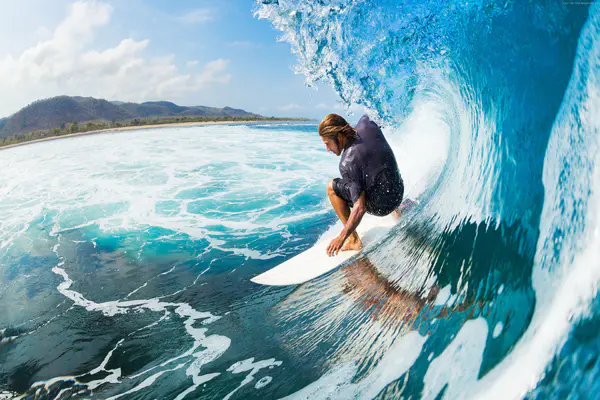Surfing is a thrilling sport that relies heavily on the quality of the waves. Understanding what makes a wave good for surfing is crucial for both beginners and experienced surfers. This article will explore the key factors that determine good waves for surfing, including wave size, shape, and conditions.
Understanding Wave Formation
Wave Size and Height
The size of a wave is one of the most important factors for surfing. Waves can range from small, gentle rollers to massive, powerful breaks. Here’s what to consider:
- Small Waves: Ideal for beginners. They are easier to handle and allow surfers to practice balancing and paddling.
- Medium Waves: Suitable for intermediate surfers. They offer a bit more challenge without being overwhelming.
- Large Waves: Best for advanced surfers. They require skill and experience to ride safely.
Wave Shape
The shape of a wave affects how it breaks and how it can be ridden. There are several key shapes:
- Beach Breaks: Waves that break over sandbars. They are often inconsistent but can offer fun rides.
- Point Breaks: Waves that break around a point of land. They are usually more consistent and can provide long rides.
- Reef Breaks: Waves that break over a coral reef. They are often powerful and can be challenging.
Factors Affecting Wave Quality
Swells
Swells are groups of waves caused by distant storms. They travel long distances and can affect wave quality. Here’s what you need to know:
- Ground Swell: Results in more powerful waves. It’s the best type of swell for experienced surfers.
- Wind Swell: Created by local winds. It usually produces choppy waves that are less ideal for surfing.
Tides
Tides can significantly impact wave quality:
- High Tide: Can make waves more powerful but may also lead to faster, less predictable waves.
- Low Tide: Often exposes more reef or sandbanks, which can create challenging conditions.
Wind Conditions
Wind plays a crucial role in wave quality:
- Offshore Wind: Blows from the land towards the sea. It helps clean up the waves and make them more rideable.
- Onshore Wind: Blows from the sea towards the land. It can make waves choppy and less enjoyable.
Surfing Locations
Different locations offer varying wave conditions:
Hawaii
Hawaii is known for its powerful waves and surf spots:
- Pipeline: Famous for its perfect barrels.
- Waimea Bay: Known for its big waves and challenging conditions.
Australia
Australia has a variety of surf spots with different wave types:
- Bondi Beach: Popular for beginners and intermediate surfers.
- Snapper Rocks: Known for its long, peeling waves.
California
California offers diverse surfing experiences:
- Malibu: Known for its long, mellow waves.
- Mavericks: Famous for its huge waves and big wave surfing.
Choosing the Right Wave
For Beginners
Beginners should look for:
- Small, gentle waves.
- Beach breaks with soft, sandy bottoms.
- Mellow conditions with minimal wind.
For Intermediate Surfers
Intermediate surfers can handle:
- Medium-sized waves.
- Point and beach breaks with consistent swells.
- Moderate wind conditions.
For Advanced Surfers
Advanced surfers seek:
- Large, powerful waves.
- Reef and point breaks with strong swells.
- Challenging conditions with suitable safety measures.
Safety Tips for Surfing
Know Your Limits
Always surf within your skill level to avoid accidents. Assess the wave conditions and choose waves that match your experience.
Use Proper Equipment
Wear a wetsuit for warmth and a leash to keep your board close. Consider using a surfboard designed for the specific wave conditions you’ll be facing.
Understand Local Hazards
Different surf spots have unique hazards:
- Sharks: Be aware of shark activity in the area.
- Reefs and Rocks: Know where they are to avoid injuries.
- Rip Currents: Learn how to recognize and deal with them.
See Also: What Is a Kook in Surfing Terms
Training and Preparation
Physical Fitness
Surfing requires strength, endurance, and flexibility. Focus on:
- Core Strength: Essential for balance and control.
- Cardiovascular Fitness: Important for paddling and overall stamina.
- Flexibility: Helps with maneuvering on the board.
Skill Development
Practice key skills such as:
- Paddling Techniques: Efficient paddling helps you get to the waves.
- Pop-Up Skills: Essential for standing up on the board quickly.
- Wave Reading: Understanding how waves will break helps with positioning.
Conclusion
In conclusion, identifying the perfect wave for surfing is a multifaceted process that requires an understanding of various elements. The ideal wave size will vary from person to person based on skill level, but generally, waves between 2-8 feet in height are most suitable. The shape of the wave should be consistent with a clear peak and a steep face, allowing for a smooth ride. Wave speed should also be taken into account; faster waves can be thrilling but may be challenging for beginners, while slower waves are more manageable.
Consistency in wave formation is key, as it allows surfers to anticipate and prepare for each wave. Wind conditions play a significant role, with offshore winds typically providing better surfing waves than onshore winds. Tide conditions can alter the wave’s characteristics, and surfers should be aware of how high or low tides can affect their surfing experience. Beach morphology and swell direction also influence wave quality, with gentle slopes and angled swells generally producing better waves.
Water clarity can enhance the overall experience, enabling surfers to see the wave and bottom contours more clearly. Lastly, safety should always be the top priority when selecting waves to surf, avoiding hazardous conditions and potential risks such as strong currents or rocky terrain. By considering these factors, surfers can find the best waves for their skills and enjoy a safe and exhilarating surfing session.

